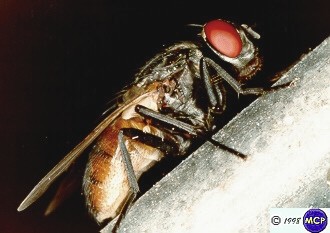
26 kb
The thorax is gray with four equally broad dark longitudinal stripes on the dorsum. The wing veins are assigned names and numbers for use in describing and identifying different species of flies. The area between adjacent veins is called a cell.

113 kb
The wing possesses a system of ridges or veins which provide support and also seved as the paths for air and blood circulation during the development of the wing before the fly emerged from the puparium.

65 kb
The abdomen has yellowish sides on the basal half; the posterior portion is brownish-black and a dark longitudinal line extends along the midle of the dorsum. The legs are blackish-brown. Below and behind the place of attachment of each wing is a bulb-shaped stalked structure called a haltere which aids in maintaining equilibrium during flight.

118 kb
Musca domestica is particularly attracted to human food but also to excrements and any kind of filth; pathogens can be regurgitaded on to the food via the vomit drop.

107 kb
The wing of Musca domestica shows the fourth longitudinal vein M1+2 curving forward to nearly meet the vein R4+5 at the wing margin.

128 kb
Under favorable conditions, females become receptive approximately 36 hours after emergence. Most female house flies mate once, storing sperm in their spermathecae to be used later to fertilize eggs for 3 or more weeks. During the process of copulation the wings of the highly promiscuous males quickly become frayed as a result of vigorous action by females resisting their attentions.

56 kb
During daylight hours, adult house flies aggregate near breeding areas and sources of food and moisture. The largest portion of a given fly population remains outdoors during warm weather; however, aggregation indoors may occur during cool, wet, or windy conditions.

110 kb
The larva is white, cylindrical whith the posterior end broad and flattened; it tapers anteriorly. There are three larval instars, of which the first two last about 24 h, and the third for 3 or more days. The rate of larval development through the three instars depends on temperature within the range suitable for survival. Given a choice, young larvae seek areas with a temperature of 30-37oC. As larvae become older they move to areas of lower temperatures and can survive ibn a wide range of temperatures.

38 kb
The spiracles are the openings for air to enter the respiratory system of the larva. The posterior spiracles of the third-instar larva each have three distinctly sinuous slits surrounded by a heavily sclerotized ring with a conspicuous perforated button that extends inward from the mesal side.

156 kb
The puparium of of house flies is reddish brown, almost evenly rounded at each end; the cuticle is slightly dulled by very fine transverse striations. The puparial stage may last 3-5 days at 35oC and high humidity but in less favourable conditions it may occupy several weeks.

88 kb
Upon completion of adult development, the adult pushes off the anterior end of the puparium. A circular slit appears in segment six of the puparium and the detached cap splits into two parts. This is done with the ptilinum, an inflated sac that protrudes from the frontal region of the head just dorsal to the base of the antennae of the adult fly.